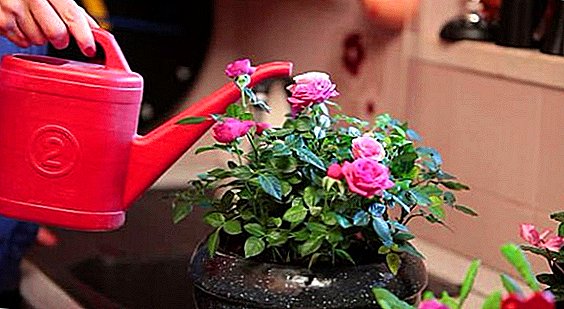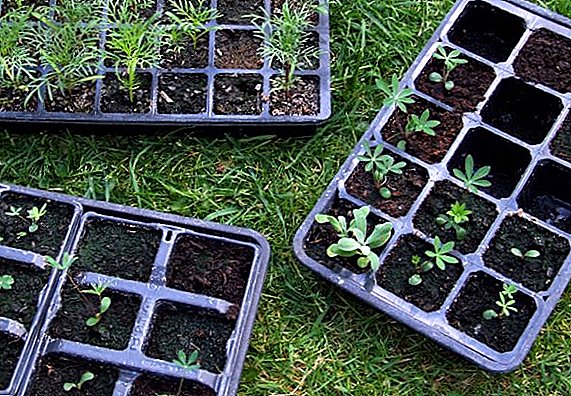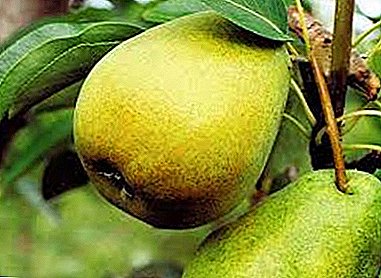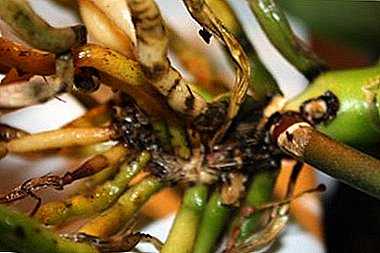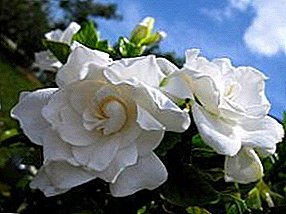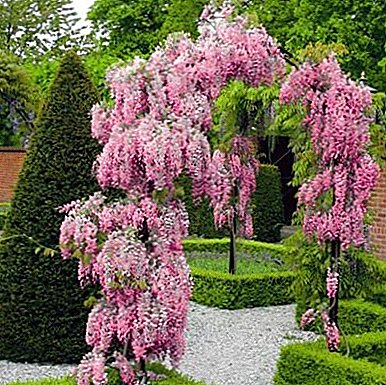
Wisteria is a plant from a fairy tale, a beauty with inflorescences up to half a meter long. Elegant, gentle, flowing, fragrant. It is possible to describe for a long time, but it is better to see at least a photograph in order to imbue with reverent admiration for the beauty of wisteria.
Kinds
Wisteria (Wisteria) - Deciduous vine, a representative of legumes. It has 10 species, 8 originated in East Asia, 2 - in North America. Wisteria is a strong plant that quickly fills all possible space around it, hardy. Well formed by man. Long growing in one place.
Wisteria flower looks like a pea flower. Small flowers are collected in the inflorescence brush. Color range from white to purple. The fruit is a bob up to 30 cm long. The leaves are complex, very beautiful.
Chinese Wisteria (Wisteria chinensis) - initially grows in East Asia. The length of the branches reaches 15 - 20 meters. The leaves are large, pinnate. Flowers in various specimens from white to lilac form a brush 15–30 cm long, which blooms almost simultaneously. It starts flowering in spring, until autumn it can dissolve one-piece inflorescences.
It grows quickly, twists counterclockwise, retains decorative qualities until the autumn due to golden leaves. Easy to care for and take any form. It can be grown indoors in a large, up to several tens of liters, pot volume (barrels). Under the conditions of the Black Sea coast, upright forms are grown, as a garden variant with a terry flower shape.
Multicolor Wisteria (Wisteria floribunda) - The length of the branches is up to 10 meters, the leaves are rather large, complex. A brush about half a meter in size. Color from blue to purple. Dissolve gradually. It blooms later Chinese wisteria, fruits hold on throughout the winter. Blooms more abundant, frost resistance and decorative higher. Grow more often vertically.
Beautiful Wisteria (Wisteria venusta) - grows to 10 meters. The main difference is the velvety pubescence of complex leaves, especially on the underside of the leaf, and beans. The flowers are large, up to 2.5 cm, form a flower up to 20 cm. There are varieties with white and purple terry flowers.
Bush wisteria (Wisteria frutescens) - reaches 10 m in height, the branches look like willow branches. Flowers from blue to purple, smaller than other types of wisteria. On the territory of Russia it grows in the Crimea, in Moldova and Uzbekistan. One of the types of wisteria that transfers indoor conditions. It looks like a high-silica wisteria.
Wisteria Macrokisty (Wisteria macrostachya) - found in bush form. For this reason, and because there are no qualities of frost resistance, it can be grown indoors, on balconies and terraces. In the variety "Blue moon" blue or white buds eventually saturate their color.
Flowering wisteria
Wisteria (from the Greek. Glycos - sweet) got its name because of the fragrant flowers, which are still very beautiful. The aroma is sweet, pleasant, comparable to the aroma of acacia. There are types of wisteria with milder or lighter flavors. The flowering of wisteria is not only tangible beauty, but also olfactory beauty. All wisteria adore the growing conditions of their homeland: light, heat, humidity, no temperature fluctuations, humus-rich soil.
The first bloom does not come soon. If wisteria was grown from seeds, it can come in 10 to 15 years. The plants propagated by cutting or rooting will begin to bloom in 7 years, and the flowering will be much more abundant.
The plant begins to bloom before the leaves bloom. As a rule, this is May - June.
- Why does not Wisteria bloom? The answer is simple:
- insufficiently lit by the sun;
- made a lot of nitrogen-containing fertilizers;
- incorrectly pruned;
- insufficiently watered during budding.
In the wild, wisteria may not wake up after winter, if the summer was dry. Root growth will grow, but the flowering of the plant itself may not be another 3 - 4 years.
Flower buds develop on the shoots of the second year. To create the conditions for flowering in the Russian conditions, it is necessary to form wisteria in the standard form: a small tree or palmette. The latter method is good for decorating the borders of a plot or decorating a wall. The boom is convenient for providing care for the plant, which includes pruning and shelter for the winter with fabric material.
Wet covering material and standing water in winter and early spring are detrimental to wisteria.
Period after flowering

To wisteria bloomed profusely, pruning should be carried out 2 times a season. The first pruning is needed in order to shorten the side shoots by more than half the length. The second pruning shorten the branches after leaf fall, leaving no more than 5 buds on the branch. After spring inspection, wisteria is tied to a support and pruned for 2 to 3 buds. At this time, the buds are very well distinguished: the flower bud is round and the growth one is flat.
There is another trick that causes wisteria to bloom more abundantly. This pruning of the branches after 2 weeks by 10 - 15 cm throughout the growing season. Stimulation of lateral shoots and their pinching causes the flower buds to form on short sprigs more intensively.
Adhere to this rule should be strictly if you want to get a flowering plant. The formed tree will bloom more abundantly and faster.
Growing wisteria
The main purpose of wisteria - decoration hanging buds. To emphasize the beauty of flowers, the plant is sent on a support. To do this, use the arches, pergolas, fences and walls. If you do not follow the wisteria, it will enclose everything in its path, up to the drain pipes. The only condition for the preparation of the support is that it must be very strong to withstand the weight of the branches and flowers.
English gardeners, the most respected in the world, argue that wisteria is mostly frost resistant, and temperatures below 25 are not threshold. Nevertheless, without much effort, it can be grown only in the southern latitudes of our country.
The first 3 years of wisteria growth are the most important: a plant skeleton is formed, pruning wisteria increases the formation of flowering buds. If pruned correctly, wisteria will be a durable tree and will not require rejuvenation. But if conditions so require, wisteria can be gradually rejuvenated by removing the stem every year and directing the escape to the right place. Pruning carried out almost to the ground.
Features of growing indoor varieties
Wisteria grows well in the tub on the balcony, terrace, southern room. During the growing season she needs light and heat. Mandatory dressing, otherwise the plant will cease to bloom. In the tub, wisteria is well-stacked.
In the fall, after trimming, the tub is carried out to the veranda or to another room, where it is cool enough (8 - 10 degrees), windy and not damp. Watering is rare and not plentiful. In early spring, form a plant, leaving 2 - 3 flowering buds wisteria and put on a permanent place.
If after winter the wisteria is located at the south window, it will bloom rapidly. After a break of 1 - 1.5 months, flowering will resume, but not so plentiful.
If the plant does not provide a cold rest, it will not just not bloom, it will die.
Wisteria is very responsive to spraying and fertilizing with universal fertilizer. Young copies need to be transplanted every year, adults - in a few years.
After flowering, the plant is cut to half the length of the branches.
Annual plant can be transplanted to a permanent place in the garden. For this, any fertile soil is suitable and the time from spring to autumn. Before landing it is soaked in water for 2 hours. The root of the seedling in the hole is placed horizontally, immediately establish a support and tie up the stem. Watering seedlings needed after disembarkation. After 1 - 2 days, the plant is shortened by 20 cm, leaving 2 - 3 escapes. During the season they grow by 2 - 2.5 meters. Larger copies in our conditions will require disparate costs. Dry branches should be cut, and curly to send on a support. In winter, the plant is spud and stop watering.
Despite the luxurious appearance, wisteria is not a very capricious plant. If you follow the basic rules of care, you can achieve abundant annual long flowering.
A photo
Below you can see a photo of how Wisteria blooms:




- Types of Wisteria
- Wisteria Blue Moon
- Wisteria care in the garden
- Propagation of Wisteria
- Planting Wisteria



